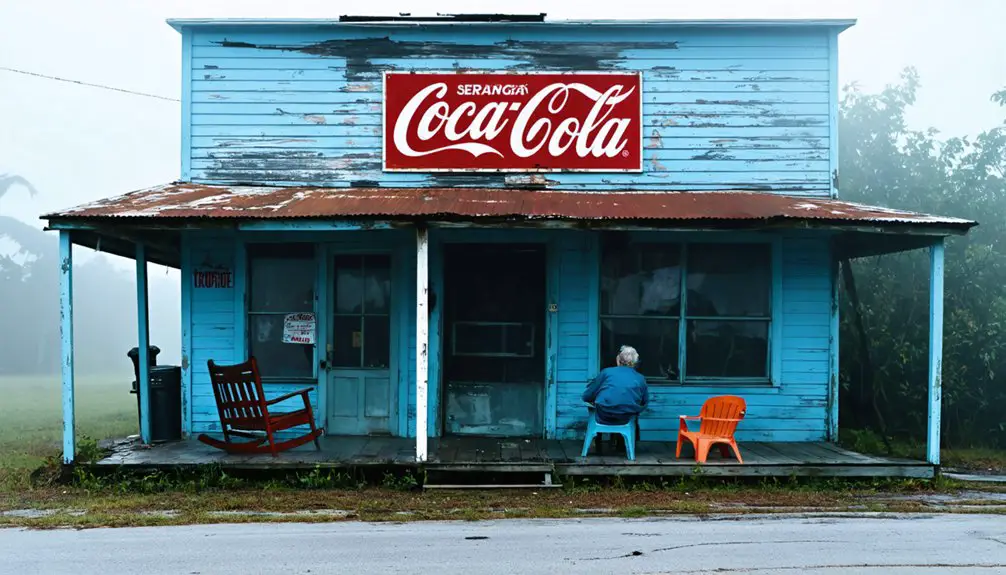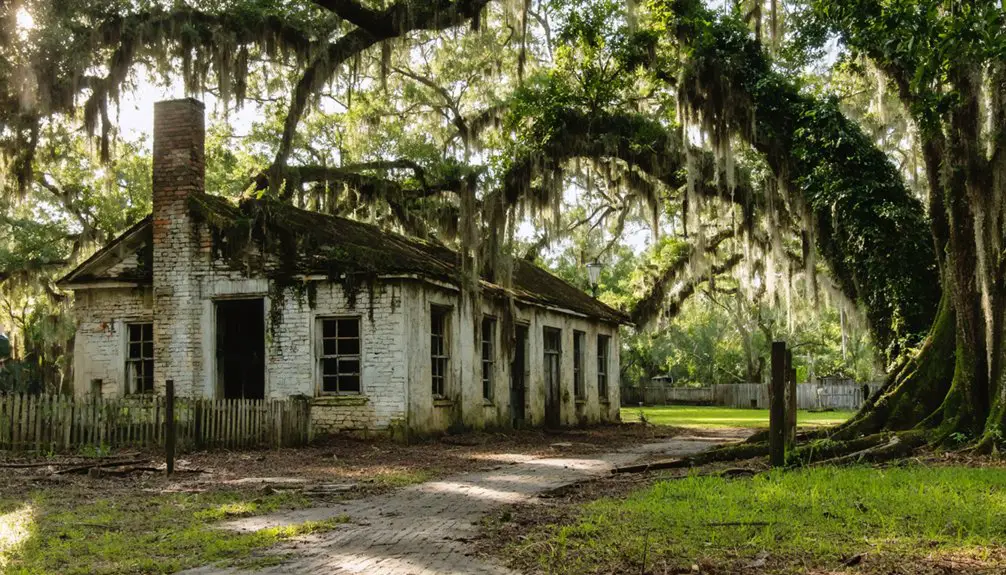You’ll find Welchton about 6 miles northwest of Lake Weir in Marion County, Florida. Founded in 1884 by Captain John M. Welch, this former railroad town started as an ambitious grape-growing settlement with 200 Italian immigrants. Despite its promising beginnings with a 40-room hotel and bustling general store, the community declined after failed grape ventures and the devastating freeze of 1895. Today, nature has reclaimed the town’s ruins, leaving behind fascinating traces of its short-lived prosperity.
Key Takeaways
- Welchton became a ghost town after failed grape cultivation ventures and the devastating citrus freeze of 1895 drove residents away.
- The town’s remaining structures include crumbling foundations of an 1868 governor’s mansion and boarded-up storefronts overtaken by forest growth.
- Originally established in 1884 by Captain John M. Welch, the town flourished briefly with 200 Italian immigrants before declining.
- The closure of the post office in 1898 marked Welchton’s final official presence, though some structural remains are still accessible today.
- Located 6 miles northwest of Lake Weir in Marion County, Florida, the abandoned town site intersects with Silver Springs Shores community.
Location and Geographic Setting
Nestled in Marion County, Florida, the ghost town of Welchton sits approximately 6 miles northwest of Lake Weir along Highway 464 (Maricamp Road).
You’ll find this former settlement positioned near coordinates 29°5.0’N latitude and 81°59.5’W longitude, where the Silver Springs Shores community now intersects the historical site.
The land characteristics of Welchton’s original 7,000 acres featured extensive pine forests, typical of central Florida’s mixed flatwoods and agricultural ridges.
The old train depot from 1895 still stands today as a gift shop, serving as a reminder of the town’s railroad heritage.
Regional influences shaped the area’s development, with the Atlantic Coast Line Railroad once serving as a crucial transportation link between Ocala to the north and Candler to the south.
The railroad brought in daily train passengers who frequently stopped at the town’s prominent 40-room hotel for meals and lodging.
While the terrain proved challenging for early agricultural attempts, particularly grape cultivation, the location’s strategic position along both rail and highway corridors made it a significant stop for travelers and commerce.
Historical Settlement Origins
Archaeological evidence reveals that long before Welchton’s establishment, indigenous peoples inhabited this region of Marion County as early as 8000 B.C. The Muscogee, Creek, and Euchee tribes developed thriving communities here, leaving behind artifacts that demonstrate their long-term presence and cultural influences on the area.
The settlement patterns that would later shape Welchton emerged from the region’s logging and agricultural roots. Like many West Florida communities, the area’s development was closely tied to the timber industry, with logging roads and rail trams crisscrossing the landscape. Similar to the early pineapple plantations that emerged in Viking, Florida during the 1890s, agriculture played a vital role in the region’s development. Surveys have documented 47 archaeological sites across Escambia, Santa Rosa, and Walton counties, providing insights into historical settlement patterns.
Early homesteaders established farms despite challenging sandy soil conditions, while lumber operations, such as those run by Southern States Lumber Co., provided employment and spurred community growth. These combined influences created the foundation for Welchton’s eventual establishment.
Early Community Development
During its early development in the late 19th century, Welchton emerged as a vibrant community centered around its thriving lumber operations and agricultural endeavors.
You’d have found the town’s heart beating around its central square, where the general store and post office served as gathering spots for residents and travelers alike. A bustling cypress sawmill anchored the town’s economic growth during this period. Community cohesion flourished through regular town meetings, church gatherings, and seasonal festivals that brought everyone together.
The town’s civic engagement was evident in its growing infrastructure, with a small schoolhouse providing education to local children and a local constable maintaining law and order.
Like many Florida communities of its time, Welchton’s residents relied on the railroad for transportation and commerce, while horse-drawn carriages connected them to neighboring settlements. Following the pattern of pioneer mail service, daily communication was facilitated by steamers and stagecoaches that delivered letters and packages to the townspeople.
Agricultural Heritage and Economy
While Florida’s warm climate presented unique agricultural opportunities, Welchton’s farmers quickly adapted their cultivation practices to harness the subtropical environment. Through crop diversification, they grew citrus fruits, sugar cane, tobacco, bell peppers, tomatoes, and watermelons. Strawberry crops were especially profitable since Plant City area produced 34% of America’s winter strawberries.
You’ll find that early settlers experimented extensively, learning to navigate unexpected freezes that could devastate their harvests. The region’s agricultural success helped drive personal net income of $14.8 billion statewide by 2000.
Livestock integration played an essential role in Welchton’s agricultural economy. Dating back to Spanish colonial times, cattle ranching flourished along the St. Johns River.
Farmers grew fodder corn specifically for livestock, while European forage crops like bluegrass and clover improved pasture quality. This agricultural variety contributed greatly to Florida’s robust farm economy, which generated billions in fruit, vegetable, and livestock production by the early 2000s.
Population Changes Over Time
Founded in 1884, Welchton’s population grew rapidly as Captain John M. Welch established the town with a vision of creating a thriving grape-growing community.
You’ll find that about 200 Italian immigrants soon arrived to work the orchards, forming the backbone of this budding settlement.
The population decline began when grape cultivation failed due to poor soil preparation.
After shifting to citrus, the devastating freeze of 1895 dealt another blow to the community, much like how the great freeze of 1894-95 devastated numerous other Florida settlements.
Much like High Coria’s experience with the Sherman Mill Company, the arrival of industry brought temporary population growth that couldn’t be sustained.
You can trace the migration patterns as residents gradually moved to nearby Candler and other local towns.
By 1898, the post office’s closure marked a significant exodus.
The once-bustling town, with its 40-room hotel and general store, eventually faded into obscurity.
Today, Welchton’s former territory lies within Silver Springs Shores, its distinct boundaries erased by time.
Infrastructure and Transportation
You’ll find Welchton’s early infrastructure centered around the Atlantic Coast Line Railroad, which provided essential passenger service and shipping access for the agricultural town.
The railroad stop featured a convenient arrangement where trains would pause at the Welchton hotel for passenger meals, while the surrounding 2WD roads, including Hy 464 (Maricamp Road), offered ground transportation options.
The town’s thoughtfully planned infrastructure included unusually well-constructed brick roads, which, along with the railroad, enabled residents to travel to nearby Ocala for shopping and connected the community to broader commercial networks.
Historical Transportation Routes
During the 19th century, Welchton’s transportation infrastructure relied heavily on Florida’s extensive waterway system, with steamboats serving as the primary means of connecting the settlement to neighboring regions.
You’ll find ghostly journeys traced along the riverways where steam-powered vessels once navigated challenging water levels and seasonal droughts. The U.S. Army Corps of Engineers worked to improve these forgotten pathways through dredging operations and canal development.
The expansion of the Intracoastal Waterway later enhanced marine accessibility, though low water levels occasionally hindered navigation, as evidenced by the dredge Florida’s struggles in 1918.
These water routes remained essential until technological advances brought diesel engines and more modern vessels, gradually transforming how people and goods moved through the region.
Railroad and Road Access
While Welchton’s early development centered around waterways, the Atlantic Coast Line Railroad became the town’s essential transportation artery, connecting its agricultural ventures and local industries to broader markets.
You’d find daily trains stopping at the town’s 40-room hotel, where passengers could enjoy meals during their journey. The railroad significance was particularly evident in supporting the ambitious 7,000-acre grape cultivation project and local sawmill operations.
Two-wheel-drive roads connected Welchton to Lake Weir, positioned 6 miles northwest along Highway 464. However, these basic grid routes weren’t suited for heavy traffic or adverse weather.
Over time, road deterioration and declining rail use paralleled the town’s economic struggles. Today, Silver Springs Shores development has largely overtaken Welchton’s former transportation infrastructure, with minimal traces remaining visible.
Natural Disasters and Challenges

Located in Marion County, Florida, Welchton faced numerous natural disasters and environmental challenges that ultimately contributed to its decline.
You’ll find that agricultural challenges began with the ill-fated grape cultivation ventures, where unsuitable soil conditions and lack of proper preparation led to widespread crop failures. The natural disaster impacts intensified in 1895 when a devastating freeze destroyed the remaining citrus crops, dealing another blow to the struggling community.
The region’s subtropical climate proved hostile to farming efforts, with periodic droughts, hurricanes, and flooding from nearby wetlands threatening both infrastructure and agriculture.
You’ll notice that soil erosion, combined with pest infestations and diseases fostered by high humidity, created an unsustainable environment for farming. These combined factors eventually forced residents to adapt or abandon their agricultural pursuits.
Present-Day Remnants
Today’s visitors to Welchton will find a haunting collection of structural remnants scattered throughout the former town site.
You’ll discover the crumbling foundations of the 1868 governor’s mansion, now partially hidden by encroaching saw grass and pine forest. The ruins tell a story of abandonment through boarded-up storefronts and deteriorating apartment complexes exposed to salt air and graffiti.
For ruin exploration enthusiasts, the site offers numerous abandoned buildings, though you’ll need to navigate carefully through fallen trees and dense undergrowth.
Nature reclamation is evident everywhere, with forest growth steadily consuming former roads and structures.
While some areas remain off-limits due to private ownership or safety concerns, you can still access many visible ruins, particularly if you’re willing to hike through the remote, forested terrain.
Local Stories and Landmarks

When Captain John M. Welch established his ambitious settlement, he created several landmarks that defined Welchton’s identity.
You’ll find the town was anchored by a grand three-story, 40-room hotel where train passengers stopped daily for their noonday meals. Local legends tell of the bustling general store that supplied everything from hardware to clothing for both residents and visitors.
The cultural influences of roughly 200 Italian immigrants shaped the community’s character, evident in their superior housing construction with overlapping sides rather than typical pioneer vertical boards.
You’ll discover the town was strategically positioned six miles northwest of Lake Weir along today’s Highway 464, with the Atlantic Coast Line Railroad serving as its lifeline.
The Post Office, which closed in 1898, marked the town’s final official presence.
Frequently Asked Questions
Are There Any Reported Paranormal Activities or Haunted Locations in Welchton?
You won’t find documented paranormal sightings or haunted locations in this area. Since the town’s structures vanished and Silver Springs Shores took over, there’s no evidence of supernatural activity remaining.
What Indigenous Tribes Originally Inhabited the Welchton Area Before Settlement?
Like ripples across ancient waters, you would’ve found Native settlements of Timucua culture in the area first, followed by Creek migrants who later became part of the Seminole tribe.
How Do Current Residents Feel About Welchton’s Ghost Town Designation?
You won’t find documented community opinions about Welchton’s ghost town status, as the area’s now absorbed into Silver Springs Shores and current residents don’t typically identify with or express pride about it.
Were There Any Notable Crimes or Lawlessness During Welchton’s Peak Years?
You won’t find any documented crime statistics or law enforcement issues during Welchton’s peak years. The town’s decline stemmed from agricultural failures rather than criminal activity or social unrest.
Does Welchton Have Any Protected Historical Buildings or Preservation Ordinances?
Hey digital explorer, you won’t find any protected buildings or preservation ordinances in Welchton today. Records don’t show any architectural significance that’s earned historical preservation status in this area.
References
- https://cccourthouse.org/wp-content/uploads/2023/12/Ghost-towns-and-Cemeteries-of-Citrus-County.pdf
- https://www.youtube.com/watch?v=fAu5kj5Q5uo
- https://ghosttownadventures.wordpress.com/2018/03/
- https://en.wikipedia.org/wiki/List_of_ghost_towns_in_Florida
- https://www.wikiwand.com/en/articles/List_of_ghost_towns_in_Florida
- https://www.ghosttowns.com/states/fl/welchton.html
- https://www.youtube.com/watch?v=bNjqcQ5SMwg
- https://www.youtube.com/watch?v=0XuNR0AOlQU
- https://www.emeraldcoastmagazine.com/ghost-towns-of-west-florida/
- https://www.youtube.com/watch?v=TxBONhwNi1k



